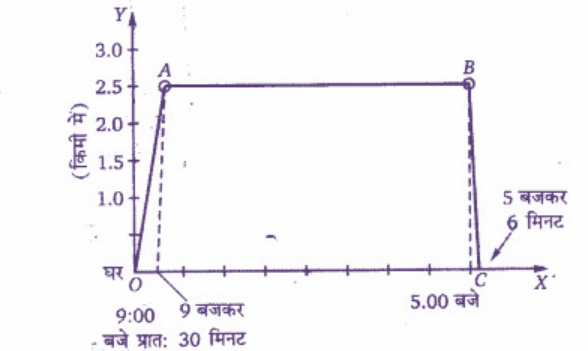NCERT Solutions For Class 11 Physics Chapter 3 Motion In A Straight Line in Hindi - 2025-26
FAQs on NCERT Solutions For Class 11 Physics Chapter 3 Motion In A Straight Line in Hindi - 2025-26
1. What is the first step in solving any numerical from NCERT Class 11 Physics Chapter 3, Motion in a Straight Line?
The first and most crucial step is to establish a frame of reference and a consistent sign convention. You must define an origin (x=0) and specify the positive direction (e.g., rightwards or upwards). All vector quantities like position, displacement, velocity, and acceleration must then be assigned a positive or negative sign based on this convention. This systematic approach, as per the CBSE 2025-26 pattern, prevents common errors in final solutions.
2. How do you correctly solve NCERT questions that differentiate between distance and displacement?
To find the correct solution for questions involving both concepts, follow these distinct steps:
- For distance, you must calculate the total length of the path actually travelled by the object. It is a scalar quantity and is always positive.
- For displacement, you must find the shortest straight-line distance between the object's initial and final positions. It is a vector, so its direction (indicated by a sign) is crucial. For example, if an object moves from x = +5m to x = -2m, the displacement is the final position minus the initial position: (-2m) - (+5m) = -7m.
3. What is the step-by-step method for solving problems on average velocity and average speed from the NCERT exercises?
For a correct NCERT solution, it is essential to use the correct formula for each term:
- Average Speed: This is calculated by dividing the total path length (total distance covered) by the total time interval. It is a scalar quantity.
- Average Velocity: This is calculated by dividing the total displacement (final position - initial position) by the total time interval. It is a vector quantity.
A key check for your answer is that the average speed is always greater than or equal to the magnitude of the average velocity.
4. How can I apply the three kinematic equations to solve problems of uniformly accelerated motion in the NCERT exercises?
To correctly apply the kinematic equations (v = u + at, s = ut + ½at², v² = u² + 2as), you must first confirm that the problem involves constant acceleration. Then, follow this method:
- List all known variables (initial velocity 'u', final velocity 'v', acceleration 'a', displacement 's', time 't') with their correct signs based on your chosen frame of reference.
- Identify the unknown variable you need to calculate.
- Select the kinematic equation that links all your known variables with the single unknown variable.
- Substitute the values with their signs into the equation and solve.
5. How are position-time (x-t) and velocity-time (v-t) graphs used to find solutions for motion problems in the NCERT textbook?
Graphs are a key tool for solving motion problems. The correct method to interpret them for NCERT solutions is:
- From a position-time (x-t) graph, the slope at any point gives the instantaneous velocity.
- From a velocity-time (v-t) graph, the slope gives the acceleration, and the area under the curve gives the displacement.
Analysing the shape of the graph (straight line vs. curve) helps determine if the motion involves constant velocity or constant acceleration.
6. Why is it crucial to establish a sign convention when solving NCERT problems on motion in a straight line?
Establishing a sign convention is critical because key quantities in this chapter—position, displacement, velocity, and acceleration—are vectors, meaning they have both magnitude and direction. The sign (+ or -) represents their direction relative to a chosen origin. Without a consistent sign convention, your calculations for displacement and the application of kinematic equations will result in incorrect answers, a common reason students lose marks in exams.
7. In the context of NCERT solutions, when should I use instantaneous velocity instead of average velocity?
You should use average velocity when a question asks for the overall velocity over a specific duration (e.g., between t=2s and t=5s). In contrast, you must use instantaneous velocity when a question asks for the velocity at a single, specific moment in time (e.g., 'at t=3s'). For problems involving a position function x(t), instantaneous velocity is found by calculating the derivative, dx/dt.
8. How do I solve an NCERT problem where an object has zero velocity but non-zero acceleration?
This classic scenario occurs when an object reaches its maximum height after being thrown vertically upwards. At this highest point, its instantaneous velocity is momentarily zero as it changes direction. However, the acceleration is still the non-zero acceleration due to gravity (g ≈ -9.8 m/s²). To solve such NCERT questions, you must set the final velocity 'v = 0' in the appropriate kinematic equation to find quantities like maximum height or time of ascent.
9. Why are the standard kinematic equations not applicable for solving all motion problems in NCERT Chapter 3?
The three standard kinematic equations are derived under the single, fundamental assumption of uniform or constant acceleration. They cannot be used to obtain a correct solution if the acceleration changes with time (non-uniform acceleration). For NCERT problems involving variable acceleration, you must use the methods of calculus. Typically, this involves integrating the acceleration function to find the velocity function, and then integrating the velocity function to find the position.



























